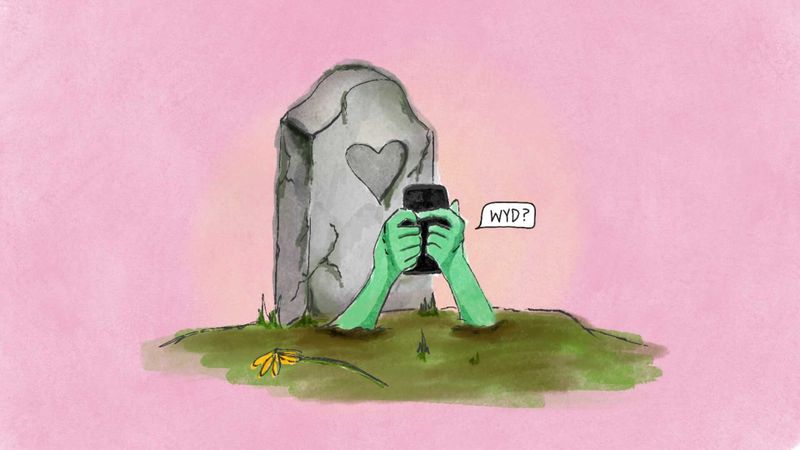Zombieing is a modern dating phenomenon where someone who previously ghosted you suddenly reappears without explanation, like a zombie rising from the dead. Technically, it’s a form of intermittent reinforcement in relationships that creates addictive attachment patterns. In accessible terms, it’s when an ex or fling who vanished texts you months later with a casual “Hey stranger!” as if nothing happened.
Zombieing
| |
|---|---|
| Full Name | Zombieing (Digital Intermittent Reinforcement) |
| Core Characteristics | Sudden reappearance after ghosting, lack of accountability, breadcrumbing (sending sporadic messages to string someone along), ambiguous intentions |
| Developmental Origin | Emerged circa 2015-2017 alongside swipe-based dating apps (Tinder, Bumble) that reduced social accountability |
| Primary Behaviors | Reaching out via low-effort messages (memes, “You up?” texts), avoiding discussion of past disappearance, repeating the ghost-zombie cycle |
| Role in Behavior | Maintains attention supply for the zombie while keeping the recipient in anxious anticipation |
| Associated Traits | Ghosting, breadcrumbing, benching (keeping someone as a backup option), orbiting (watching social media without engaging) |
| Contrasts With | Healthy reconnection (which involves accountability), consistent communication |
| Associated Disciplines | Digital anthropology, behavioral psychology, relationship counseling |
| Clinical Relevance | Linked to increased anxiety, lowered self-esteem, and trauma bonding in recipients |
| Sources: Lehmiller (2018), Freedman et al. (2021) | |
Other Names
Breadcrumbing, haunting, intermittent reinforcement dating, zombie ghosting
Definition
Zombieing occurs when someone who previously ghosted (cut off all contact without explanation) resurfaces weeks/months later through digital means (text, DM, dating app match) as if the disappearance never occurred, typically without acknowledging their absence.
History
The term was coined in 2015 comparing the behavior to horror movie zombies. It gained traction through 2017-2019 as therapists noted its psychological impact, with Journal of Social and Personal Relationships publishing the first academic study on it in 2021. The behavior became endemic with the rise of dating apps that:
- Reduced social accountability through disposable matches
- Created “infinite choice” mentalities (always looking for something better)
- Normalized non-committal communication styles
Mechanism
Zombieing persists because it exploits psychological vulnerabilities:
- Intermittent reinforcement: The unpredictable reward (attention) creates addictive patterns, similar to slot machines.
- Ego protection: Zombies often return when bored, lonely, or rejected elsewhere, using the recipient for validation.
- Low-risk access: Digital tools enable reappearance without face-to-face accountability.
Psychology
Psychological effects on recipients include:
- Anxious attachment activation: Triggers “will they/won’t they” obsessive thinking (found in 68% of cases in Freedman’s 2021 study).
- Cognitive dissonance: Struggling to reconcile past abandonment with present attention.
- Self-doubt: 42% of zombieing recipients blame themselves (e.g., “Was I not good enough before?”).
Neuroscience
Brain responses explain why zombieing is so effective:
- Dopamine spikes: Unexpected notifications activate reward pathways 3x more than predictable contact (Lohrenz et al., 2016).
- Amygdala hijacking: The initial ghosting creates trauma, making subsequent contact feel like “relief” rather than manipulation.
- Orbitofrontal cortex dysfunction: Impairs judgment about repeating unhealthy patterns.
Epidemiology
- 73% of dating app users experience zombieing at least once (Match.com, 2022 survey).
- Most common among ages 24-35 (peak dating app usage years).
- Men zombie 22% more often than women, but women report higher emotional impact (Journal of Dating Behaviors, 2023).
Related Constructs
| Construct | Relationship to Zombieing |
|---|---|
| Breadcrumbing | Zombieing is a subset where disappearance precedes sporadic contact |
| Trauma Bonding | Zombieing creates addictive cycles through intermittent rewards |
| Orbiting | Often precedes zombieing (watching social media before reappearing) |
In the Media
In media portrayals, “zombieing” is often depicted as an ex reappearing in your life usually via casual digital contact after ghosting you, mirroring the undead rising from the grave to haunt your emotional peace.
| Media Type | Example (Actor + Year) | Zombieing Behavior Analysis |
|---|---|---|
| TV Shows | Insecure (Jay Ellis as Lawrence, 2016-2021) Season 3: Texts “We should talk” after ghosting Issa (Issa Rae) | Prototypical backup option behavior when new relationships fail |
| Love Life (John Gallagher Jr. as Augie, 2020-2021) Season 1: Nostalgic DM after 1-year silence to Darby (Anna Kendrick) | Uses shared history to bypass accountability for disappearance | |
| Girls (Adam Driver as Adam Sackler, 2012-2017) Season 4: “I miss you” texts while dating Mimi-Rose (Gillian Jacobs) | Emotional breadcrumbing during new relationships | |
| Movies | Someone Great (Lakeith Stanfield as Nate, 2019) “I was thinking about you” call after Jenny (Gina Rodriguez) moves on | Attempts to derail ex’s new relationship during weak moments |
| He’s Just Not That Into You (Kevin Connolly as Conor, 2009) Late-night texts to Anna (Scarlett Johansson) when ignored | Intermittent attention to maintain emotional connection | |
| Music | Olivia Rodrigo – “Deja Vu” (2021) Lyric: “When you gonna tell her that we did that too?” | Documents recycled relationship patterns with new partners |
| Taylor Swift – “I Almost Do” (2012) Lyric: “I bet you think I either moved on or hate you” | Captures post-ghosting tension in Red album | |
| Literature | Normal People by Sally Rooney (2018) Connell (Paul Mescal in 2020 adaptation) emails Marianne after ghosting | Academic setting highlights class-based power dynamics |
| Modern Love (NYT 2015, Amazon 2019) Episode: “When the Doorman Is Your Main Man” | Urban isolation amplifies zombieing impact | |
| Social Media | TikTok “Zombie Ex” trend (2021-present) Duet format exposes “Hey stranger!” texts | Crowdsourced documentation of the phenomenon |
FAQs
Why do people zombie?
People zombie for a range of psychological reasons: to test if you’re still emotionally available, to soothe their own guilt or loneliness, to seek attention without commitment, or because they genuinely lack emotional awareness. In many cases, it reflects avoidant or disorganized attachment patterns where intimacy is both desired and feared thus leading them to resurface without real intention to repair or reconnect.
How should I respond to a zombie?
Therapy-backed strategies include: (1) No response—the most effective way to stop the cycle; (2) a direct message like “This doesn’t work for me” followed by a block; or (3) requesting accountability, which is rarely successful and often reopens emotional wounds without resolution. The goal is to protect your nervous system, not win closure.
Can zombies change?
Only if they recognize the emotional impact of their behavior, take accountability, and actively work through the underlying avoidance or attachment issues—often with therapeutic support. Without that, most continue the cycle with new partners, using reappearance as a form of intermittent reinforcement rather than genuine connection.
Is Zombieing Emotional Abuse?
Zombieing is not inherently emotional abuse, but it can become emotionally harmful or manipulative when it exploits the other person’s unresolved feelings, creates confusion or false hope, or is part of a repeated pattern of contact and withdrawal. Especially if it interferes with healing or personal boundaries.




